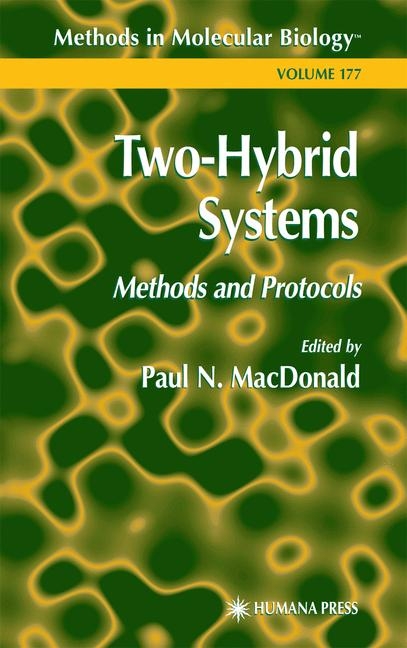
Two-Hybrid Systems
Humana Press Inc. (Verlag)
978-1-61737-210-0 (ISBN)
- Titel ist leider vergriffen;
keine Neuauflage - Artikel merken
The development of more recent methodologies, such as mammalian expression systems, immunopurification schemes, expression cloning strategies, surface plasmon resonance (BiaCore), and nanosequencing technologies, has contributed a wealth of new insights into these complex multiprotein mechanisms and clearly accelerated the discovery process. Arguably, the yeast two-hybrid system has been one of the predominant and most powerful tools in this discovery process.
Part I. General Methods The Two-Hybrid System: A Personal View Stanley Fields and Paul L. Bartel Growth and Maintenance of Yeast Lawrence W. Bergman Media Formulations for Various Two-Hybrid Systems Michael Saghbini, Denise Hoekstra, and Jim Gautsch Yeast Two-Hybrid Vectors and Strains Philip James High-Efficiency Transformation of Plasmid DNA into Yeast Robin A. Woods and R. Daniel Gietz Qualitative and Quantitative Assessment of Interactions Monica M. Montano Strategies for Rescuing Plasmid DNA from Yeast Two-Hybrid Colonies, Alyson Byrd and Rene St-Arnaud Part II. False Positives Two-Hybrid System and False Positives: Approaches to Detection and Elimination Ilya G. Serebriiskii and Erica A. Golemis Confirming Yeast Two-Hybrid Protein Interactions Using In Vitro Glutathione-S-Transferase Pulldowns Dennis M. Kraichely and Paul N. MacDonald Two-Hybrid Interactions Confirmed by Coimmunoprecipitation of Epitope-Tagged Clones Louie Naumovski Part III. Applications Smad Interactors in Bone Morphogenetic Protein Signaling Xiangli Yang and Xu Cao Protein Interactions Important in Eukaryotic Translation Initiation Katsura Asano and Alan G. Hinnebusch Steroid Receptor and Ligand-Dependent Interaction with Coactivator Proteins Sergio A. Onate Interaction of Cellular Apoptosis Regulating Proteins with Adenovirus Anti-Apoptosis Protein E1B-19K Thirugnana Subramanian and G. Chinnadurai Part IV. Alternative Strategies Mammalian Two-Hybrid Assays: Analyzing Protein-Protein Interactions in the Transforming Growth Factor-_ Signaling Pathway Xin-Hua Feng and Rik Derynck One-Hybrid Systems for Detecting Protein-DNA Interactions Mary Kate Alexander, Brenda D. Bourns, and Virginia A.Zakian The Split-Hybrid System: Uncoding Multiprotein Networks and Defining Mutations That Affect Protein Interactions Phyllis S. Goldman, Anthony J. DeMaggio, Richard H. Goodman, and Merl F. Hoekstra Three-Hybrid Screens: Inducible Third-Party Systems Bjorn Sandrock, Franck Tirode, and Jean-Marc Egly Three-Hybrid Screens for RNA-Binding Proteins: Proteins Binding 3' End of Histone mRNA Zbigniew Dominski and William F. Marzluff Membrane Recruitment Systems for Analysis of Protein-Protein Interactions Ami Aronheim
"The utility of the technique makes this book worthwhile since all the information necessary to get started is included. Anyone should be able to start using the two-hybrid system in their lab using this book as a guide. The book is written for all levels of expertise from student to senior investigator. Each chapter is written by an expert in that particular area. The protocols are detailed and easy to follow and even the preparation of standard buffers is described. A great deal of information on basic yeast techniques is provided for investigators who have not previously worked with yeast. Each chapter contains numerous notes and insights on what to keep an eye out for and potential problems. This would be an excellent addition to any laboratory considering starting the two-hybrid system. The first chapter on the origins of the method is a must read for everyone, especially students."-98 Score, 5 stars, Doody's Health Science Book Review Journal"The stated goal of the volume is "to introduce the yeast two-hybrid systems to students, research assistants, research associates, and other more senior investigators considering this as a new approach." This goal is well achieved as the volume is easy to read and comprehensive. the first section of this volume provides in depth detailing of yeast protocols, including several very useful trouble shooting solutions and tips well beyond the scope of those found in the instruction manuals accompanying commercial kits.this book is a worthwhile investment to ensure that the most is gained from your two-hybrid experiments and thus I would recommend it." - Molecular Biotechnology"This current volume is a practical, laboratory manual with detailed methods and trouble-shooting tips for the yeast two-hybrid approach. The volume includes a brief historical overview, with chapters addressing yeast husbandry and media preparation and yeast genetic modification. The manual lso includes detailed accounts of how to construct a two-hybrid screen and how to analyse the positives. I found the book easy to read, and the protocols were clear and straightforward to follow. There are a number of useful tables, including yeast genotypes and genetic markers as well as available vectors. I would recommend this book as a practical laboratory manual for anyone contemplating a search for a partner protein using the yeast two-hybrid approach." -The Endocrinologist
| Reihe/Serie | Methods in Molecular Biology ; 177 |
|---|---|
| Zusatzinfo | biography |
| Verlagsort | Totowa, NJ |
| Sprache | englisch |
| Maße | 152 x 229 mm |
| Gewicht | 516 g |
| Einbandart | Paperback |
| Themenwelt | Naturwissenschaften ► Biologie ► Mikrobiologie / Immunologie |
| Naturwissenschaften ► Biologie ► Zellbiologie | |
| ISBN-10 | 1-61737-210-2 / 1617372102 |
| ISBN-13 | 978-1-61737-210-0 / 9781617372100 |
| Zustand | Neuware |
| Haben Sie eine Frage zum Produkt? |
aus dem Bereich


